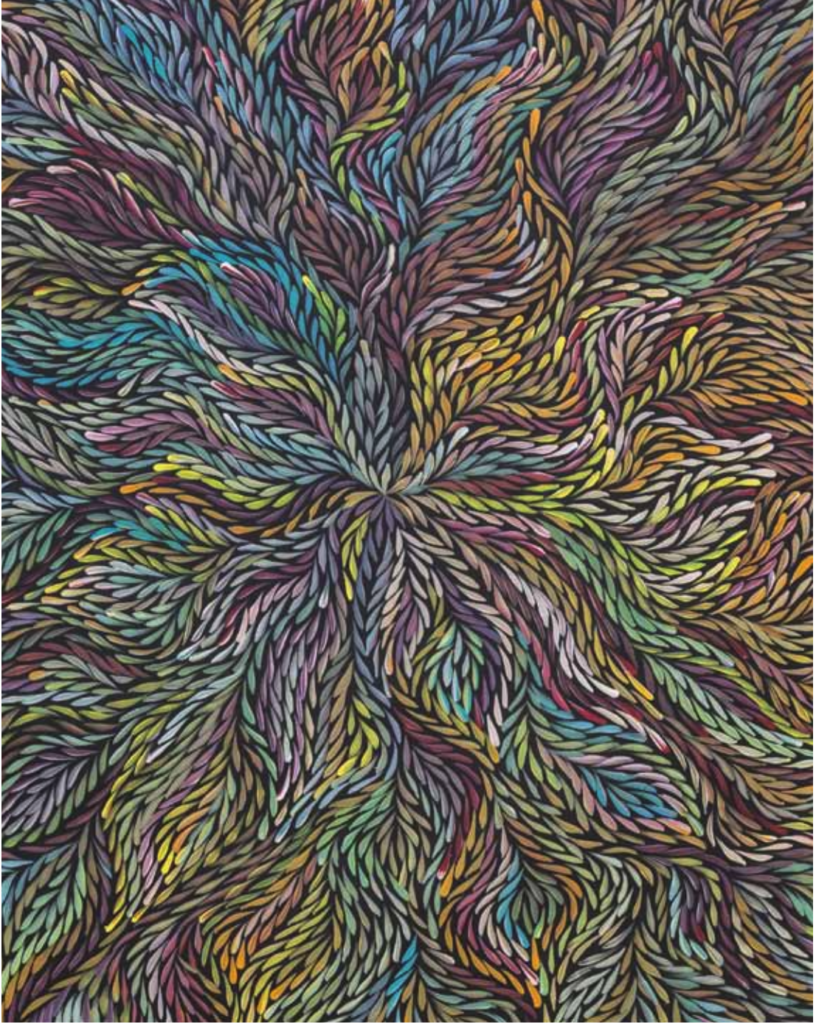``DESERT, SPIRIT, ROCK``: LANDSCAPES OF THE MIND
INDIGENOUS AUSTRALIAN DESERT ART AND CHINESE SCHOLAR'S ROCK
“The Aboriginal people of Australia and my mother’s family share a long connection, both to each other, and in dedication of their lives to the country they love. My maternal grandfather, a true pioneer of the deep north-east of the continent, is all too familiar how equally harsh the flora and fauna of the lusher tropics can be – and over the course of now near one hundred years he has learnt too her unexpected secrets to sustaining human life. For an artist and appreciative eye, Australia possesses enviable natural beauty and a unique richness of bio-diversity. Compounded to this is exquisite light, infinite textural capacity, and the endless, intoxicating layers of fragrance. But, for all its visual beauty and Mother Nature’s sensory concoctions are the fits and starts of mental isolation and spiritual attachment to which the human condition is inevitably prone when alone in such vast landscapes. I imagine my grandfather experienced spells of each as gatekeeper, infiltrator and caretaker of the jungle from young teenage-hood throughout his adult life – often alone, much like an artist, and particularly an Indigenous Australian artist with deep knowledge of the land.
On the move – this decade eastwards – are the art works themselves. Chinese audiences have enjoyed a growing number of Australian Aboriginal art exhibitions over recent years. In 2010 the National Museum of China (NAMOC) staged the exhibition Aboriginal Art from Australia’s Deserts featuring the works of artists from Papunya and Balgo. Forming part of Imagine Australia: the Year of Australian Culture in China this was a multi-disciplinary arts festival of Australia’s finest visual arts, film, literature, music, dance and new media, which opened to throngs of delighted crowds by then Australian Ambassador to China, Dr Geoff Raby. More recently, between 2011-2013, Australian curator Gary Proctor has staged a major and hugly popular touring exhibition Tu Di ~ Shen Ti (My Land, My Body) at state and private museums up and down the country. Based on a selection of works from the Warburton Art Centre’s collection, it is the largest Australian art exhibition ever staged in China. Furthermore, the past decade has seen a sharp uptake in cultural reciprocity between Australia and China, with Chinese artists traveling to the spiritual and cultural heartlands of indigenous Australia and creating works inspired by their encounters there.
It is my great pleasure to showcase a beautiful selection of Aboriginal Australian art in Beijing and moreover to work with someone as informed, professional and dedicated to her chosen field of expertise as Sascha Gianella. Now based in Geneva, Switzerland, Gianella is highly respected in her field for her knowledge and close relationships with some of the most high profile artists from the wide Aboriginal art community of Australia. Our collaboration focuses on works inspired by the Central desert region of Australia and within this vast geographical area, Gianella has selected a group of renowned female Aboriginal artists and works with important community provenance. As Gianella explains to interviewer Michelle Ho, female Aboriginal Australian artists have historically played second fiddle to male artists, traditionally given the task of filling backgrounds and body painting; like men however, Aboriginal women have played a key role in social cohesion and the works in Desert Spirit Rock play tribute through a focus on ceremony (Mbitjana and Watson) and the powers of natural healing (Jeannie and Gloria Tamerre Petyarre).
This exhibition is defined by another millennia old incarnation of landscape – Chinese Scholar’s Rocks. The gnarled forms, like the Indigenous Australian pictures and alongside them, share highly symbolic, non-naturalistic qualities; but if the paintings exude vital, Dionysian qualities, the Scholar’s Rock instills Apollonian contemplation and deep quietude. Part natural evolution, part artisan’s intervention, Scholar’s Rocks were first collected for the context of domestic studies in the Tang Dynasty (618-907 A.D.), with larger examples making their first appearances in gardens also at this time. Most coveted in form were stones as nodular as possible, with allusions to soaring peaks or dark, dimpled caves, intended to evoke much wider landscapes of the mind. Essential too was the impression of an absent human hand – the writhing, reaching forms almost rejection to interference and over-think in favour of the process – much as the unfolding of the calligrapher’s score, his tool not simply the brush but the engagement of his whole body with the material and spiritual.
The result, an illusion of involuntary, unpremeditated ephemerality captured in Scholar’s Rocks, underscores one of the key aspirations of traditional Chinese artistic practice. Closely interwoven as the visual arts of China historically were, Scholar’s Rocks made their first appearance in Chinese painting sometime mid-way through the Tang dynasty, and, like classical Chinese painting, the hand behind the Scholar’s Rock remained unknown and the works themselves undated.
It is gratifying to now witness a renewed (and worldwide) interest in the Scholar’s Rock as a feature of contemporary Chinese painting, with reverence shown through the exacting verisimilitude of skillful contemporary artists such as Liu Dan, Li Huayi and Zeng Xiaojun. In the case of all artists inspired by the natural world, whether of the open Australian desert or the confines of the Chinese scholar’s chambers, they are not only inspired by nature, sympathetic to her, but given over to her ability to both dissipate and conversely, to distill.”
– Curator: Emily de Wolfe Pettit
